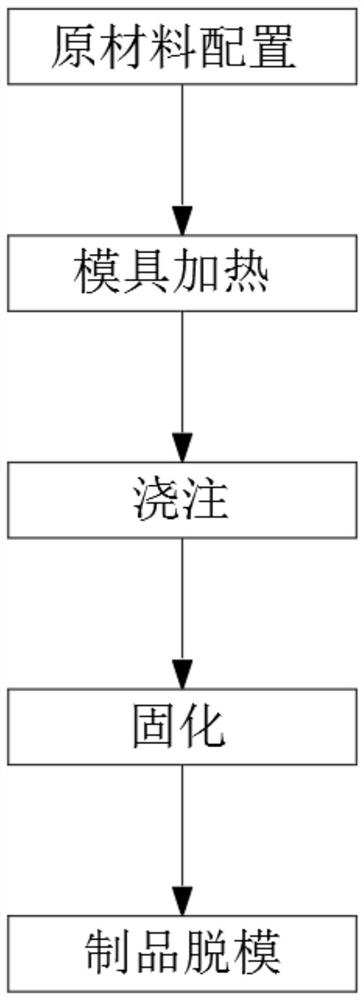Static pouring process of epoxy resin basin-type insulator
A pot-type insulator and epoxy resin technology, applied in the field of epoxy resin pot-type insulators, can solve the problems affecting the electrical performance of the insulator, cracks in the epoxy resin layer, hidden dangers, etc., to avoid electrical performance, improve brittleness, and prevent rupture. Effect
- Summary
- Abstract
- Description
- Claims
- Application Information
AI Technical Summary
Problems solved by technology
Method used
Image
Examples
Embodiment 1
[0020] refer to figure 1 as shown,
[0021] A static casting process for epoxy resin pot insulators, comprising the following steps: raw material configuration, mold heating, pouring, curing and product demoulding, the raw material configuration includes epoxy resin, filler, curing agent and plasticizer for mixing Heating, wherein the plasticizer is a polyamide resin;
[0022] Heat the mold to be poured to prevent sink marks of the epoxy resin mixture during pouring due to excessive temperature difference between the mold and the epoxy resin mixture;
[0023] Fix the mold to be poured and pour the mixed raw materials into the interior of the mold;
[0024] The raw material mixed inside the mold is transferred from a liquid state to a hot solid state, usually using a two-step curing process, that is, pre-curing at a lower temperature and post-curing at a higher temperature. The solidification process at this time is the conversion process from the liquid state of the mixture...
Embodiment 2
[0033] refer to figure 1 as shown,
[0034] A static casting process for epoxy resin pot insulators, comprising the following steps: raw material configuration, mold heating, pouring, curing and product demoulding, the raw material configuration includes epoxy resin, filler, curing agent and plasticizer for mixing Heating, wherein the plasticizer is polysulfide rubber;
[0035] Heat the mold to be poured to prevent sink marks of the epoxy resin mixture during pouring due to excessive temperature difference between the mold and the epoxy resin mixture;
[0036] Fix the mold to be poured and pour the mixed raw materials into the interior of the mold;
[0037] The raw material mixed inside the mold is transferred from a liquid state to a hot solid state, usually using a two-step curing process, that is, pre-curing at a lower temperature and post-curing at a higher temperature. The solidification process at this time is the conversion process from the liquid state of the mixtur...
Embodiment 3
[0046] refer to figure 1 as shown,
[0047] A static casting process for epoxy resin pot insulators, comprising the following steps: raw material configuration, mold heating, pouring, curing and product demoulding, the raw material configuration includes epoxy resin, filler, curing agent and plasticizer for mixing heating, wherein the plasticizer is polyester;
[0048] Heat the mold to be poured to prevent sink marks of the epoxy resin mixture during pouring due to excessive temperature difference between the mold and the epoxy resin mixture;
[0049] Fix the mold to be poured and pour the mixed raw materials into the interior of the mold;
[0050] The raw material mixed inside the mold is transferred from a liquid state to a hot solid state, usually using a two-step curing process, that is, pre-curing at a lower temperature and post-curing at a higher temperature. The solidification process at this time is the conversion process from the liquid state of the mixture to the ...
PUM
 Login to view more
Login to view more Abstract
Description
Claims
Application Information
 Login to view more
Login to view more - R&D Engineer
- R&D Manager
- IP Professional
- Industry Leading Data Capabilities
- Powerful AI technology
- Patent DNA Extraction
Browse by: Latest US Patents, China's latest patents, Technical Efficacy Thesaurus, Application Domain, Technology Topic.
© 2024 PatSnap. All rights reserved.Legal|Privacy policy|Modern Slavery Act Transparency Statement|Sitemap

